Contents
Market Overview
Macro Review
Powell closed FOMC door on tapering (…for now). The timetable is shifting to focus increasingly on a 5bp hike in IOER in June given RRP pressure in the short-end of U.S. Treasuries. This follows the four-week T-Bill auction at 0%, which subsequently traded negative for the first time. Thereafter the market has increased emphasis on the Jackson Hole event to understand how the Fed intend to communicate and indeed action tapering at subsequent meetings. While the DXY staged a late recovery last week, it remains 1% weaker through April; with U.S. Treasuries some 6-9bp tighter as the 30yr struck the 50dma at 2.30%. Copper may have grabbed headlines in the commodity space as Comex contracts traded above $10,000/t, though nickel was up 7.4% on the week, just as palladium broke above $3,000/oz. PMIs out of China may have missed expectations, but stepping back and recognizing the strength of the numbers in March and the fact that readings are expansionary bodes well. Meanwhile, an impressive catalogue of 1Q earning beats led to the first S&P revision, with Credit Suisse revising their full-year forecast to 4,600. In fixed income, month-end activity remained subdued given Japan’s Showa Day on Thursday (meaning no overnight Treasury quotes), which also comes ahead of European holidays next week.
EM Credit Update
EM Credit ended the week down -0.4% but Local Currency was up 0.2%. Zambia, Sri Lanka and Ethiopia outperformed, while Ukraine, Lithuania and El Salvador lagged. Primary issuance remains the dominant market theme, with $289bn in aggregate year-to-date, which is split $84bn across EM Sovereigns and $205bn across EM Corporates. ESG issuance now stands at 22% of aggregate issuance, up from only 6% in 2020.
The Week Ahead
Next week’s EM agenda includes key rate decisions out of Brazil (2.75%) and Turkey (19.0%). China’s M2 and trade data will also feature high up on the list. Other rate decisions are likely to be less market moving, with the likes of Czech Republic (0.25%), Malaysia (1.75%), Poland (0.10%) and Thailand (0.50%). Beyond that, the week is set to be dominated by EM inflation releases where Turkey, Mexico and Colombia stand-out. Amidst these releases, Indonesia will also report 1Q GDP, which will follow a number of sell-side downward revisions that covered Thailand and Philippines in previous weeks.
This week’s emerging markets highlights discussed below include: Early signals from post-election political dynamics in Ecuador point to a better-than-expected governability outlook during Lasso’s presidential “honeymoon”; Mexico polls remain supportive for the ruling Morena coalition; AMLO continues to push agenda.
Fixed Income
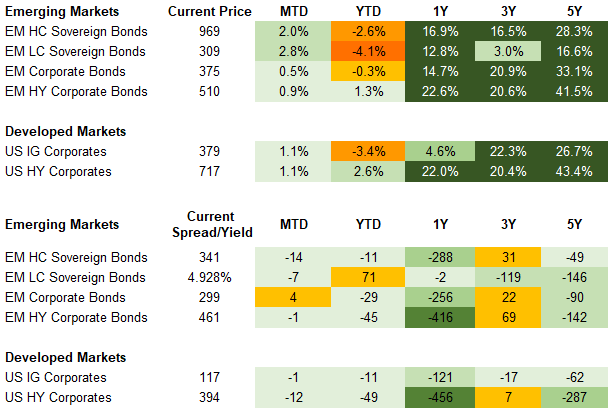
Equities
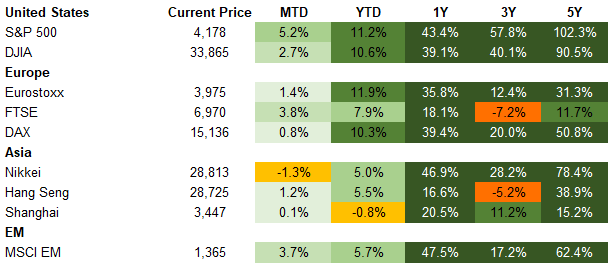
Commodities

Source for data tables: Bloomberg, JPMorgan, Gramercy. EM Fixed Income is represented by the following JPMorgan Indicies: EMBI Global, GBI-EM Global Diversified, CEMBI Broad Diversified and CEMBI Broad High Yield. DM Fixed Income is represented by the JPMorgan JULI Total Return Index and Domestic High Yield Index. Fixed Income, Equity and Commodity data is as of April 30, 2021 (Mid Afternoon).
Emerging Markets Weekly Highlights
Early signals from post-election political dynamics in Ecuador point to a better-than-expected governability outlook during Lasso’s presidential “honeymoon”
Event: Late last week, the Ecuadorian National Assembly approved the so called “dollarization defense” bill, formally granting independence to the Central Bank and setting the stage for easier discussions between President-elect Guillermo Lasso and the IMF over recalibrating Ecuador’s assistance program. Meanwhile, it seems likely that Lasso’s policy implementation capacity will depend heavily on his ability and willingness to work with the newly forged parliamentary alliance between the indigenous movement Pachakutik and center-left Izquierda Democratica (ID); signals emerging this week on potential areas of economic policy cooperation have been constructive.
Gramercy Commentary: The reform granting independence to the Central Bank was the main structural benchmark for the IMF’s ongoing review, so its approval will help unlock a $400 million disbursement under the second review of the program. The approval, after several failed attempts pre-election, has also contributed to the material improvement of investor sentiment on Ecuador since Lasso’s surprise win of the presidency three weeks ago. From a market perspective, in addition to being a firm and welcome rejection of Correismo/populism by voters, the forthcoming LassoPresidency means Ecuador now has four more years to build upon the foundation of rational economic policy management and reform momentum achieved during the outgoing Moreno Administration. It also signals that excellent relations with the U.S. government and the IMF will likely continue. After Lasso’s Administration assumes power on May 24th, its ability to deliver reforms and meet IMF economic policy conditionality will depend on the alliances it can form in the National Assembly around the most salient issues. Thus far, signals have been constructive, indicating that Lasso’s Government might enjoy better than expected governability, at least in the initial “honeymoon period” of his Presidency. The alliance of Lasso’s conservative CREO party and the Social Christian Party (PSC) has 40 seats and will need support on policy agenda items from the left-leaning block of Pachakutik and Izquierda Democratica that will control 45 seats in Ecuador’s 137-member parliament. This will require political flexibility and willingness by Lasso to move to the center on a number of issues, but we believe political wiggle room will exist, especially in the earlier stages of the Administration when political capital tends to be the strongest. In that context, we will be keenly watching the composition of Lasso’s Cabinet and key ministerial appointments, as they will signal to what extent a “national unity” narrative is likely to emerge. If the alignment of political forces in parliament and Lasso’s cabinet choices support a good governability outlook, we expect positive market dynamics for Ecuador’s sovereign debt to persist, extending the impressive post-election rally.
Mexico polls remain supportive for the ruling Morena coalition; AMLO continues to push agenda
Event: Two recent polls from Celag and Parametria indicated solid support for the ruling Morena coalition of 36% and 32%, respectively, ahead of the June 6th mid-term vote. This compares to PRI and PAN support of around 20%. Null responses remain elevated at around 30%. Meanwhile, the senate energy committee approved a bill that limits the regulator’s capacity to control gasoline prices and private sector utilization of Pemex infrastructure.
Gramercy commentary: Despite lackluster management of the pandemic and still challenging domestic economic conditions, President Andrés Manuel López Obrador (AMLO) remains popular with an approval rating of over 60%. This combined with stabilization of the virus for the time being, economic momentum on the back of the U.S. recovery, lack of enthusiasm for opposition parties, and risk of lower than typical turnout points to a decent likelihood that Morena at least maintains its simple majority. We expect the Administration to continue to pursue policies that increase the role of the state in the energy sector at the expense of private enterprise and provide incremental fiscal support to the company as necessary. Maintenance of orthodox macroeconomic policies combined with the cyclical economic recovery, should help to anchor assets in the near term, all else equal, albeit pressure on credit metrics due to structural growth and policy challenges will likely pose headwinds over time.
Emerging Markets Technicals
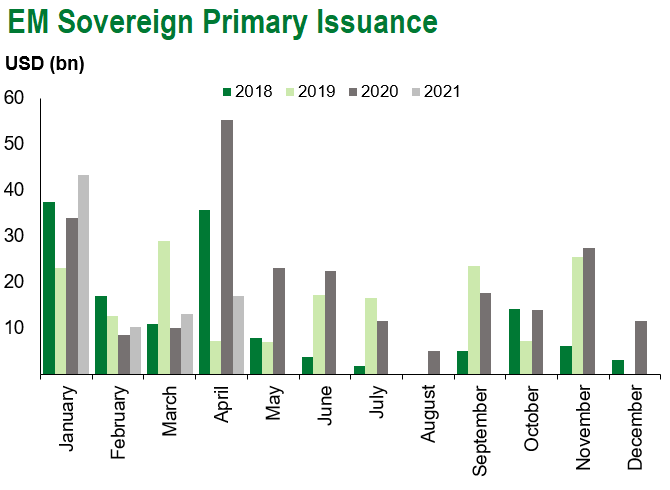
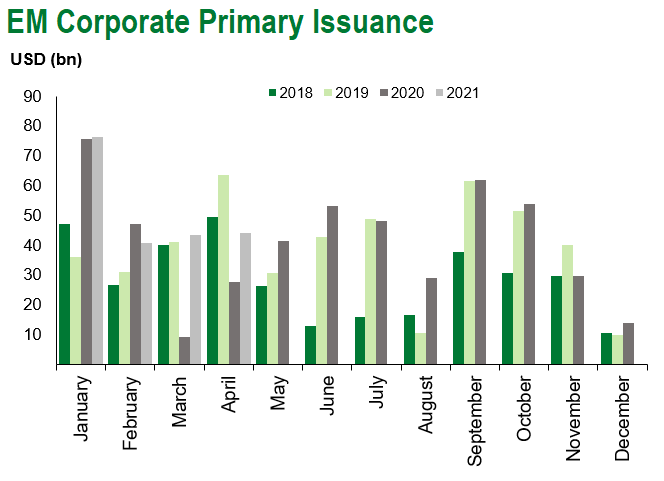
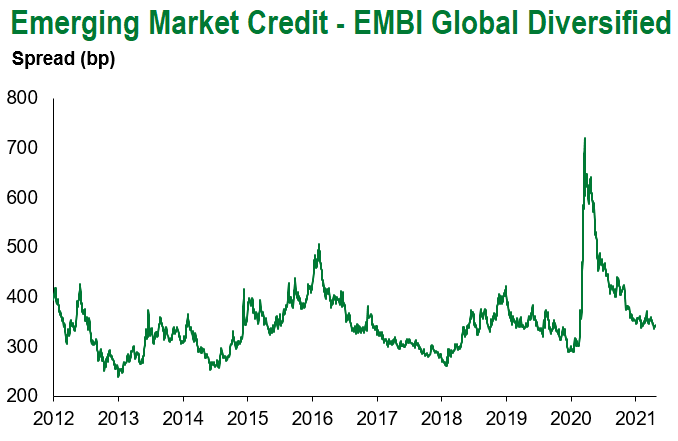
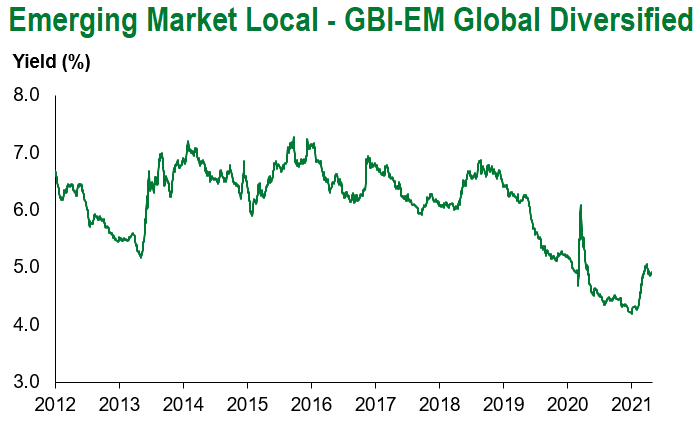
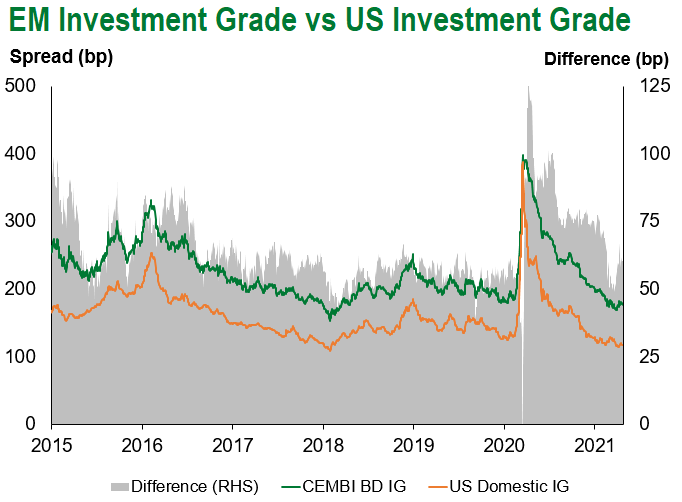
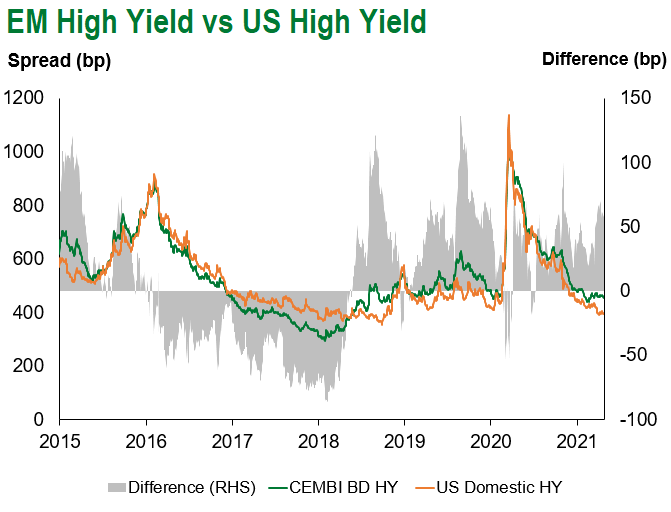
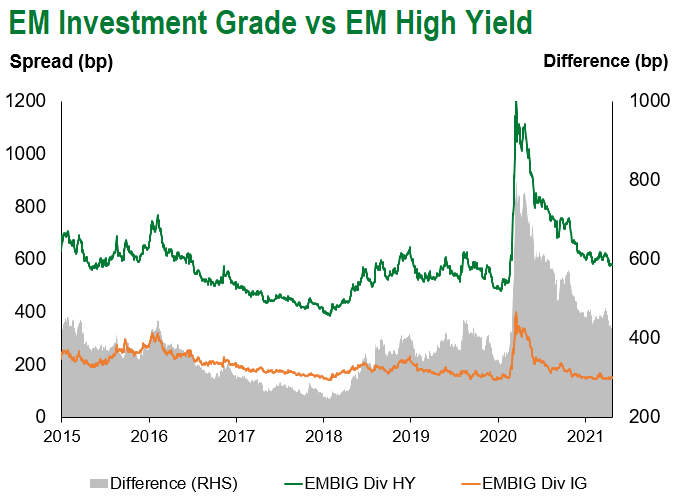
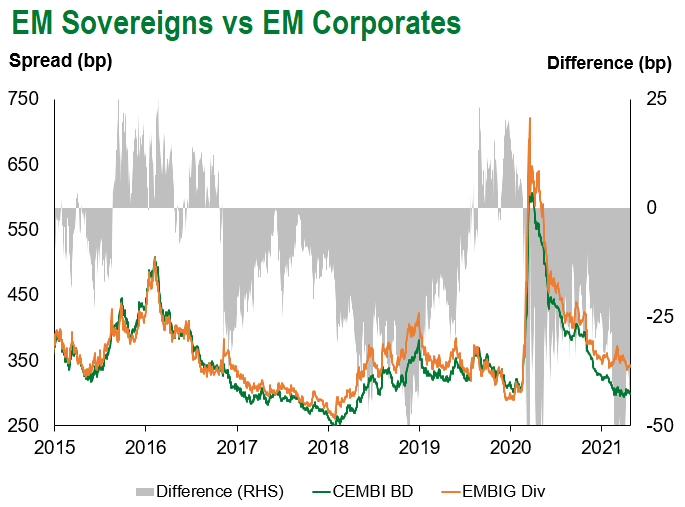
Emerging Markets Flows
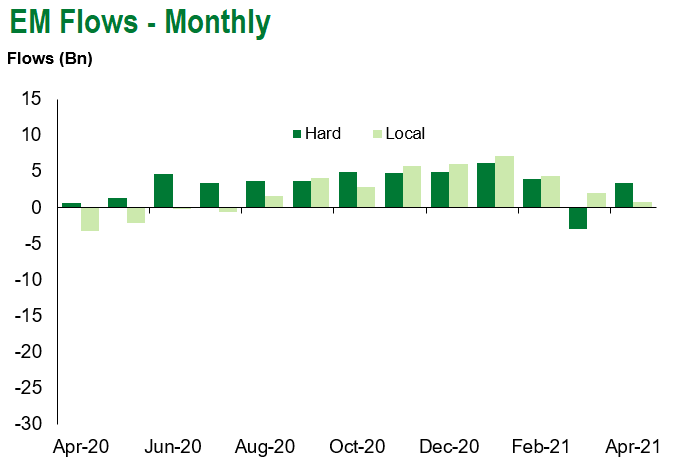
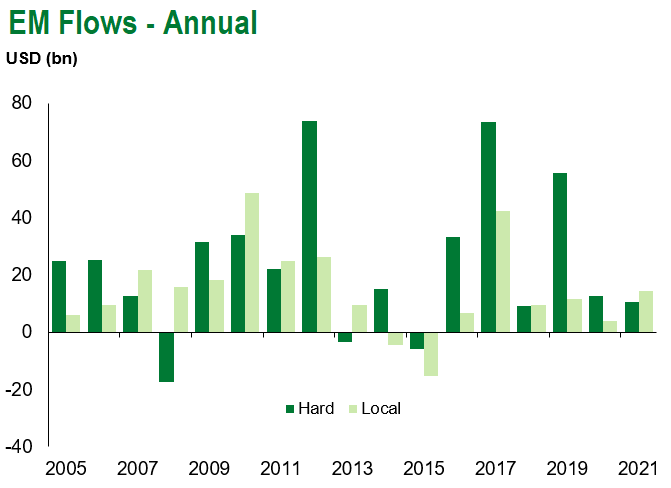
Source for graphs: Bloomberg, JPMorgan, Gramercy. As of April 30, 2021.
COVID Resources
Emerging Markets COVID-19 Case Summary
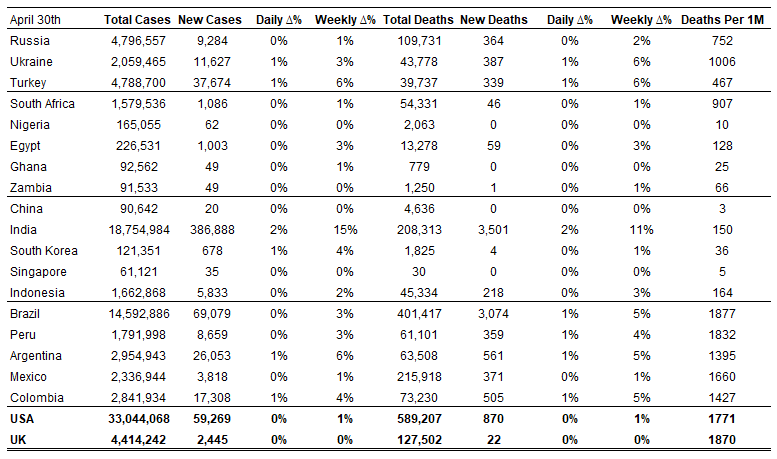
Source: Worldometer as of April 30, 2021.
Additional Crisis Resources:
Johns Hopkins COVID-19 Case Tracker
For questions, please contact:
Kathryn Exum, Senior Vice President, Sovereign Research Analyst, [email protected]
Petar Atanasov, Senior Vice President, Sovereign Research Analyst, [email protected]
Tolu Alamutu, CFA, Senior Vice President, Corporate Research Analyst, [email protected]
James Barry, Vice President, Corporate Research Analyst, [email protected]
This document is for informational purposes only. The information presented is not intended to be relied upon as a forecast, research or investment advice, and is not a recommendation, offer or solicitation to buy or sell any securities or to adopt any investment strategy. Gramercy may have current investment positions in the securities or sovereigns mentioned above. The information and opinions contained in this paper are as of the date of initial publication, derived from proprietary and nonproprietary sources deemed by Gramercy to be reliable, are not necessarily all-inclusive and are not guaranteed as to accuracy. This paper may contain “forward-looking” information that is not purely historical in nature. Such information may include, among other things, projections and forecasts. There is no guarantee that any forecasts made will come to pass. Reliance upon information in this paper is at the sole discretion of the reader. You should not rely on this presentation as the basis upon which to make an investment decision. Investment involves risk. There can be no assurance that investment objectives will be achieved. Investors must be prepared to bear the risk of a total loss of their investment. These risks are often heightened for investments in emerging/developing markets or smaller capital markets. International investing involves risks, including risks related to foreign currency, limited liquidity, less government regulation, and the possibility of substantial volatility due to adverse political, economic or other developments. The information provided herein is neither tax nor legal advice. Investors should speak to their tax professional for specific information regarding their tax situation.